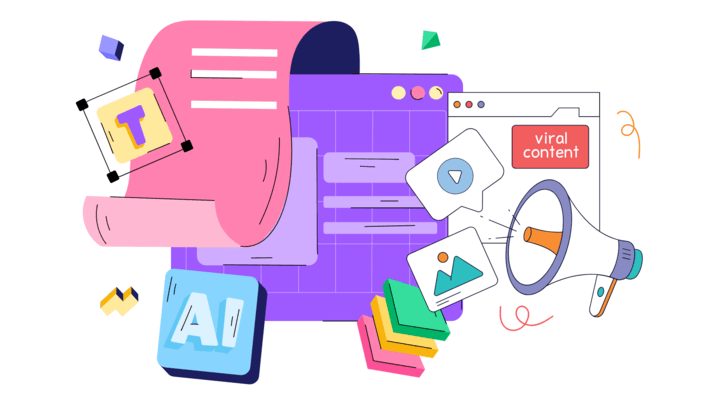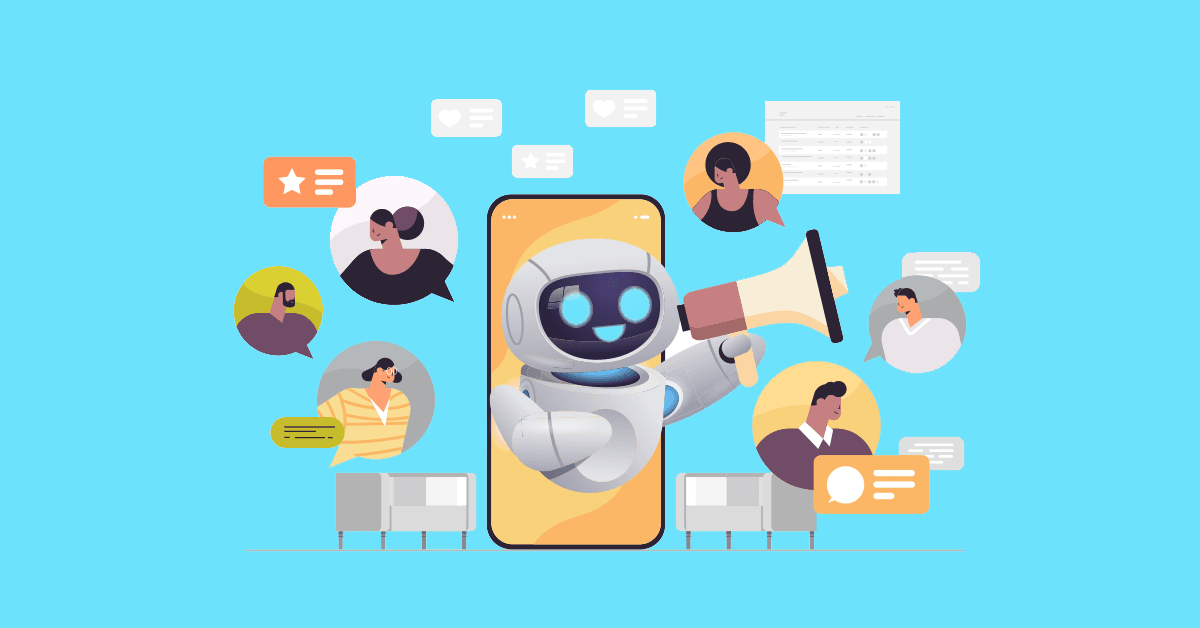LinkedIn lets you re-write your posts with AI.
Just recently, Meta confirmed they’ve used public posts on Instagram and Facebook to train their AI chatbots.
Reddit has signed deals with OpenAI and Google to provide data for their AI models’ training.
Do you see a pattern?
AI is taking social media by storm and its impact is only expected to grow.
Read on to discover some of the hottest trends for AI in social media and insights from diverse entrepreneurs. Their perspectives touch on the exciting possibilities and potential challenges surrounding the use of AI in social media.
Image by Joseph Mucira from Pixabay
1. Advanced Conversational AI: Revolutionizing Customer Service
AI chatbots have come a long way.
Initially, they were based on pattern recognition and provided only scripted responses. This often led to illogical replies. If you’ve seen it—you know how frustrating it is.
Now, natural language processing (NLP) and machine learning algorithms enable chatbots to understand and respond to human language with increasing accuracy.
What’s next?
Steve Sacona, founder of Top 10 Lawyers, believes:
 “The next generation of AI chatbots will be able to understand context and nuance in conversations effortlessly, no matter the level of professionalism or setting.
“The next generation of AI chatbots will be able to understand context and nuance in conversations effortlessly, no matter the level of professionalism or setting.
They’ll be able to handle complex customer service issues, remember details from previous interactions, detect sarcasm or frustration in user messages, and piece together different ideas into different contexts.”
Impact on Business Operations
The rise of AI technology in social media chatbots means:
- 24/7 support: Companies provide round-the-clock customer service without the need for large teams and Call Centers.
- Cost reduction: Automated support systems can significantly decrease operational costs.
- Improved customer satisfaction: Quick, accurate responses can enhance the overall customer experience.
- Personalization at Scale: AI can tailor interactions based on individual customer histories and preferences.
Challenges and Considerations
While the benefits are significant, businesses must also consider:
- The initial investment in AI technology and integration
- The need for ongoing training and maintenance of AI systems
- Striking the right balance between automated and human support.
2. Predictive Content Strategy: Staying Ahead of Trends
A predictive content strategy means using data, statistical algorithms, and machine learning techniques to anticipate audience interests and tailor content accordingly.
Have you ever wondered what makes posts viral?
Well, we might be close to finding out.
 In discussing the impact of AI on content strategy, Dane Nk, founder of ThatVideoGameBlog, notes:
In discussing the impact of AI on content strategy, Dane Nk, founder of ThatVideoGameBlog, notes:
“AI will revolutionize content strategy by predicting trends before they even have the chance to go viral.
Through analyzing data from multiple platforms, AI tools will pick out emerging topics from various sectors and recommend content ideas that are likely to go well with one’s audiences in the future.
AI for Content Creation
Here’s how you’ll need to adjust to the use of AI in social media content creation.
- Data-driven decision-making: Use AI insights to inform content planning and creation.
- Diversify content formats: Be prepared to adapt to the various formats AI predicts will trend.
- Maintain agility: Develop systems that enable rapid content production to jump on emerging trends.
- Balance AI insights with human creativity: Use AI predictions as a starting point, but infuse content with unique human perspectives.
The Future of Trend Prediction
As AI continues to evolve, we can expect even more sophisticated trend prediction capabilities, including:
- Cross-platform trend analysis
- Real-time content optimization suggestions
- Integration with content management systems.
3. Sentiment Analysis for Brand Monitoring: Understanding Public Perception
Image by Canva 
Traditionally, social media listening tools provide a basic sentiment analysis—posts can be marked as a mix of positive, negative, and neutral.
But as Jonas Torrang, co-founder of Isbrave.com, that’s just the beginning: 
“Advanced AI-powered sentiment analysis is set to provide businesses with up-to-date insights into how their target audience and the general public perceive their brand. It will go past simple positive/negative categorizations to understand complex emotions and context.”
Sentiment Analysis for Brand Growth
Here’s how more nuanced sentiment analysis can help you grow your social media presence and improve your branding:
- Implement real-time monitoring: Continuously track brand mentions and sentiment across various platforms.
- Develop rapid response protocols: Create strategies for quickly addressing negative sentiment or capitalizing on positive trends.
- Integrate sentiment data into decision-making: Use insights to inform product development, marketing strategies, and customer service.
- Track competitor sentiment: Gain a competitive edge by understanding the public perception of rival brands.
The Impact on Crisis Management
AI-powered sentiment analysis can help brands during crisis situations as it allows them to:
- Detect potential issues before they escalate
- Understand the public reaction to crisis response efforts
- Adjust messaging in real-time based on audience sentiment.
4. Multilingual Content Optimization: Breaking Language Barriers
AI-powered translation goes beyond word-for-word conversion.
It considers cultural context, idiomatic expressions, and local trends.
The end result? Content that resonates with your target audience in each market.
AI also speeds up multilingual content creation, minimizes errors, and is cost-effective.
Strategies for Effective Global Communication
Let’s consider some ideas on how you can use AI to create social media content in multiple languages.
- Invest in advanced translation tools: Use AI-powered translation services that account for context and cultural nuances.
- Develop a global content strategy: Create a framework for adapting content to different markets while maintaining brand consistency.
- Collaborate with local experts: Combine AI insights with human expertise to ensure cultural appropriateness.
- Monitor performance across markets: Use AI analytics to track how content performs in different regions and languages.
The Future of Multilingual Content
Some trends we can expect in AI-assisted multilingual content are:
- Real-time translation of live content (e.g., video streams)
- AI-powered localization of visual content, including images and videos
- Improved voice translation for audio content.
5. Enhanced Content Moderation: Creating Safer Online Spaces

Image by Canva
Every day, social media users share over 14 billion images.
Mindblowing, right?
Manual moderation is no longer an option with the massive amount of user-generated content on social media platforms.
AI-powered moderation systems can process huge amounts of content quickly and consistently.
Here’s what the CEO of Online Games, Marin Cristian Ovidiu, predicts we can expect:

“AI will play an integral role in content moderation, helping to create safer online spaces. Advanced AI systems will be able to detect not just obvious violations such as hate speech, but also more subtle forms of harassment or misinformation.”
Implementing Effective AI-Driven Moderation
To use AI in content moderation effectively:
- Develop clear community guidelines: Establish and communicate clear rules for user behavior.
- Implement multi-layered moderation: Combine AI detection with human review for complex cases.
- Continuously update AI models: Regularly train AI systems on new forms of harmful content or emerging trends in online behavior.
Balancing Safety and Free Expression
While AI can greatly improve content moderation, it’s crucial to strike a balance between creating safe spaces and allowing for free expression.
This involves:
- Transparent moderation policies
- Clear appeal processes for users
- Regular audits of AI moderation systems for potential biases.
6. Smart Content Personalization: Enhancing User Experience
We know customers prefer personalized online experiences.
And that’s why content personalization is continuously evolving. It grew from simple demographic targeting to sophisticated AI-driven systems considering a user’s behavior, preferences, and context.
While that’s great, it’s also reactive—AI personalization is based on historical data.
Dionne Ricafort, Marketing Manager of CSO Yemen, says AI will also become proactive:

“Instead of just showing users content based on their past behavior, AI will soon predict what content they need to see at different times of day or in various emotional states.”
Imagine the impact this will have on user engagement.
Maximizing the Impact of AI-Driven Personalization
Here are a few steps you can take to make the most of AI content personalization.
- Create user profiles: Integrate data from various sources to create comprehensive user profiles.
- Develop dynamic content delivery: Create flexible content management systems that adapt to real-time user needs.
- Prioritize user privacy: Implement strong data protection measures and be transparent about data usage.
- Test and adapt: Continuously refine personalization algorithms based on user engagement and feedback.
The Future of Hyper-Personalization
The future of content personalization includes:
- Emotion-based content recommendations
- Predictive personalization based on anticipated user needs
- Cross-platform personalization.
7. AI-Enhanced Visual Search: Transforming Product Discovery
Social commerce, shopping via social media platforms, is expected to reach a $1.2 trillion market value by 2025.
And there’s one AI technology that will push it even further.
It’s called “visual search.”
Visual search uses AI and computer vision to analyze images and find similar items.
According to Laurie Williams, owner of Man And Van Chelsea:

“Visual search will soon spark a shift in how users discover products on social media. Users will be able to take a photo of an item they like and instantly find similar products available for purchase.”
Leveraging Visual Search for Business Growth
Here’s how you can prepare for visual search in social commerce:
- Optimize product imagery: Create high-quality, detailed images of your products for accurate AI recognition.
- Integrate into social media strategy: Encourage users to share and tag products in their posts.
- Develop seamless purchase pathways: Create easy transitions from visual search results to product pages or purchase options.
- Collaborate with influencers: Partner with content creators to showcase your products in real-world contexts, enhancing discoverability.
The Future of Visual Commerce
As visual search technology improves, we can expect to see:
- Video-based product search and discovery
- AI-powered visual styling recommendations.
8. AI-Assisted Content Creation: Streamlining the Creative Process

Image by Canva
There are many types of AI content: blog articles, emails, landing pages, videos, sound, images, and more.
This doesn’t mean that AI content will completely replace human content.
But it does mean we’ll see more content created through a mix of human and AI efforts.
As Oliver Blackburn, CEO of Man And Van Finchley, puts it:
“AI will become an even more invaluable assistant in content creation. It’ll continue to help generate ideas, come up with first drafts, and even suggest edits to improve engagement.”
Optimizing AI-Assisted Content Creation
Here’s how you can set yourself up for success with AI-assisted social media content creation:
- Define clear brand guidelines: Ensure AI-generated content aligns with your brand voice and values.
- Use AI for ideation and research: Use AI to gather insights and generate content ideas.
- Introduce AI-powered editing tools: Let AI refine and optimize content for maximum engagement.
- Maintain human oversight: Use AI as a tool to enhance, not replace, human creativity and judgment.
The Future of AI in Content Creation
With the progression of AI technologies, we’re looking into:
- More sophisticated natural language generation capabilities
- Advanced AI-powered visual content creation tools
- Automated A/B testing and content optimization.
9. AI-Driven Influencer Partnerships: Enhancing Collaboration Effectiveness
Influencer marketing is a popular strategy for growing a brand’s social following, building awareness, and even driving sales.
However, setting up influencer campaigns is a highly manual process that requires reviewing diverse profiles, building relationships, and communicating your brand guidelines and goals.
Archie Lozada, founder of PetMeDaily, has a positive outlook on implementing AI in influencer marketing:
“AI will speed up matching brands with the right influencers. It will analyze not just follower demographics but also the sentiment of followers towards the influencer, the authenticity of engagement, and even the alignment of values between the brand and the influencer.” 
Maximizing AI-Driven Influencer Partnerships
Let’s see how AI can help you improve your influencer collaborations:
- Choose the right influencers: Use AI to analyze influencers’ content, audience engagement, and brand alignment.
- Implement AI-powered campaign tracking: Monitor and analyze the performance of influencer partnerships in real time.
- Create data-driven compensation models: Use AI insights to create fair and effective payment structures based on actual influence and results.
- Foster long-term relationships: Use AI to identify influencers who consistently deliver value and align with your brand for ongoing partnerships.
The Future of AI in Influencer Marketing
Some potential AI-backed changes in influencer marketing include:
Embracing AI for Smarter Social Media Strategies
We’re already seeing the impact of AI on social media. And there’s no reason we can expect it to stop or slow down.
Hopefully, this article has given you some insight into the future of AI in social media.
And the key to success will be quick adaptability.
Nobody knows exactly what’s coming and how it’s going to shape social media. Yet, adopting new AI technologies early and using them to enhance human work seems like a safe bet.










